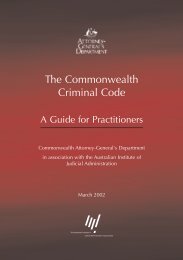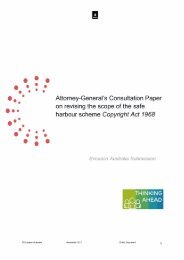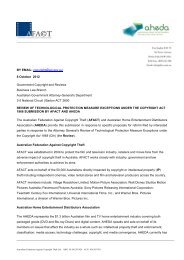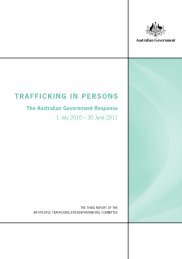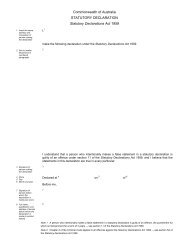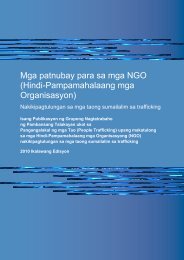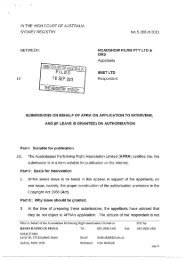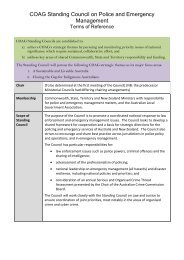Normann Witzleb [PDF 657KB] - Attorney-General's Department
Normann Witzleb [PDF 657KB] - Attorney-General's Department
Normann Witzleb [PDF 657KB] - Attorney-General's Department
Create successful ePaper yourself
Turn your PDF publications into a flip-book with our unique Google optimized e-Paper software.
confidence has so far often assumed the role of Australia’s quasi-privacy tort. Recently,<br />
the Victorian Court of Appeal in Giller v Procopets denied the plaintiff exemplary<br />
damages. 141 Relevant English authorities, on the other hand, are conflicting. While<br />
Lindsay J in Douglas v Hello! (No. 3) was ‘content to assume, without deciding, that<br />
exemplary damages (or equity’s equivalent) are available in respect of breach of<br />
confidence’, 142 Eady J held to the contrary in the more recent case of Mosley v News<br />
Group Newspapers. 143<br />
84 However, as the statutory privacy action is intended to transcend any doctrinal<br />
restraints that may exist at general law, these considerations are likely to have carried<br />
less weight than the trend in recent Australian torts legislation to prohibit or restrict<br />
exemplary damages. The NSWLRC report expressly refers to the civil liability reforms of<br />
the early 2000s that excluded exemplary damages for non-intentional personal<br />
injuries 144 and, importantly, the (Australian) Uniform Defamation Acts that also exclude<br />
claims for exemplary damages. 145<br />
85 The exclusion of exemplary damages can be supported with the argument that<br />
punitive sanctions are anomalous and do not have a proper place in private law.<br />
However, it has been widely acknowledged that exemplary damages, in particular in<br />
defamation cases, rather than being truly punitive, often aim at the disgorgement of<br />
profits made by defendants who cynically calculate that the ‘tort will pay’ even if they<br />
are held liable for compensatory damages. 146 Disallowing exemplary damages risks<br />
leaving plaintiffs without adequate protection where media defendants engage in<br />
privacy breaches with a profit-making motive. The availability of a remedy that has<br />
regard to the defendant’s profit is critical in these cases to achieve sufficient<br />
deterrence. 147 The ALRC and the NSWLRC consider that the availability of gain-based<br />
relief, such as an account of profit, will provide sufficient protection to plaintiffs. This is<br />
in contrast to the VLRC proposal, which allows for neither punitive nor gain-based<br />
damages, and therefore lacks teeth. While the VLRC does not propose to cap damages<br />
for non-pecuniary harm, more generous awards of such damages would be the wrong<br />
way to address a profit-making motive. Notwithstanding that a privacy invasion with a<br />
profit-making motive is likely to be more hurtful than an unintentional invasion, there is<br />
only a lose connection in most cases between the defendant’s profit-making motive and<br />
the plaintiff’s harm. It would therefore be unprincipled to inflate damages for nonpecuniary<br />
harm to achieve disgorgement of the defendant’s profit. The proposals of the<br />
ALRC and NSWLRC, which allow at least a gain-based measure of damages, where<br />
appropriate, are therefore to be preferred, even though it could be argued that an<br />
exemplary measure of damages may in some exceptional cases be needed to provide<br />
sufficient deterrence against gross and deliberate invasions of privacy.<br />
141 Giller v Procopets (2008) 24 VR 1; [2008] VSCA 236. See further <strong>Normann</strong> <strong>Witzleb</strong>, Giller v Procopets:<br />
Australian Privacy Law Shows Signs of Improvement (2009) 17 Torts Law Journal 121–129.<br />
142 Douglas v Hello! (No. 3) [2003] 3 All ER 996; [2003] EWHC 786 (Ch), at [273].<br />
143 Mosley v News Group Newspapers [2008] EMLR 20, [2008] EWHC 1777 (QB), at [172]-[197].<br />
144 Civil Liability Act 2002 (NSW), s 21.<br />
145 For example, Defamation Act 2005 (NSW), s 37; Defamation Act 2005 (Vic), s 37.<br />
146 For example, Cassell v Broome [1972] AC 1027; John v MGN Ltd [1997] QB 586.<br />
147 N <strong>Witzleb</strong>, ‘Justifying Gain-based Remedies for Invasions of Privacy’ (2009) 26 Oxford Journal of Legal<br />
Studies 325.<br />
29


![Normann Witzleb [PDF 657KB] - Attorney-General's Department](https://img.yumpu.com/26247895/29/500x640/normann-witzleb-pdf-657kb-attorney-generals-department.jpg)

